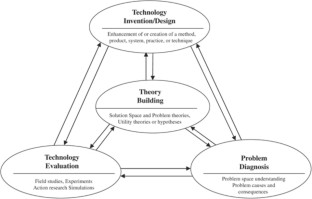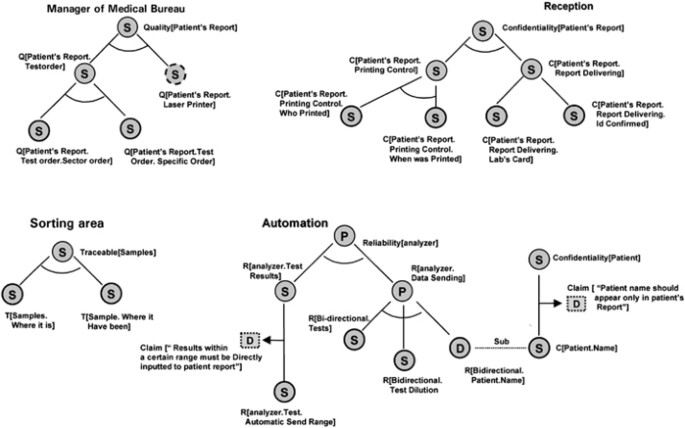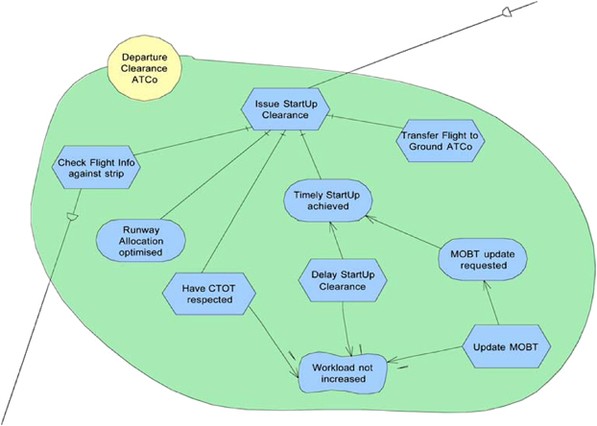Abstract
The common understanding of design science research in information systems (DSRIS) continues to evolve. Only in the broadest terms has there been consensus: that DSRIS involves, in some way, learning through the act of building. However, what is to be built – the definition of the DSRIS artifact – and how it is to be built – the methodology of DSRIS – has drawn increasing discussion in recent years. The relationship of DSRIS to theory continues to make up a significant part of the discussion: how theory should inform DSRIS and whether or not DSRIS can or should be instrumental in developing and refining theory. In this paper, we present the exegesis of a DSRIS research project in which creating a (prescriptive) design theory through the process of developing and testing an information systems artifact is inextricably bound to the testing and refinement of its kernel theory.



References
Baldwin D and Yadav S (1994) The process of research investigations in artificial intelligence – an unified view. IEEE Transactions on Systems, Man and Cybernetics 25 (5), 852–861.
Canfora G, Casazza G and De Luca A (2000) A design rationale based environment for cooperative maintenance. International Journal of Software Engineering & Knowledge Engineering 10 (5), 627–646.
Carroll J and Kellogg W (1989) Artifact as theory nexus: hermeneutics meets theory-based design. In Proceedings of CHI ‘89 (BICE K and LEWIS C, Eds), ACM Press, New York.
Cook D, Holder L and Youngblood C (2007) Graph-based analysis of human transfer learning using a game testbed. IEEE Transactions on Knowledge and Data Engineering 19 (11), 1465–1478.
Cysneiros L, Leite J and Nito J (2001) A framework for integrating non-functional requirements into conceptual models. Requirements Engineering 6 (2), 97–115.
Dasgupta S (1996) Technology and Creativity. Oxford University Press, New York.
Davies I, Green P, Rosemann M, Indulska M and Gallo S (2006) How do practitioners use conceptual modeling in practice? Data & Knowledge Engineering 58, 358–380.
Fickas S and Helm R (1992) Knowledge representation and reasoning in the design of composite systems. IEEE Transactions on Software Engineering 18 (6), 470–482.
Gause D (2005) Why context matters – and what can we do about it? IEEE Software 22 (5), 13–15.
Gentner D (1983) Structure-mapping: a theoretical framework for analogy. Cognitive Science 7, 155–170.
Goldkuhl G (2004) Design theories in information systems – a need for multi-grounding. Journal of Information Technology Theory and Application 6 (2), 59–72.
Gotel O and Finkelstein A (1995) Contribution structures [Requirements artifacts] Second IEEE International Symposium on Requirements Engineering (RE‘95), IEEE Computer Society.
Gregor S (2006) The nature of theory in information systems. MIS Quarterly 30 (3), 611–642.
Gregor S and Jones D (2007) The anatomy of a design theory. Journal of the Association for Information Systems (JAIS) 8 (5), Article 19.
Hevner A, March S, Park J and Ram S (2004) Design science in information systems research. MIS Quarterly 28 (1), 75–105.
Iivari J (1986) Dimensions of information systems design: a framework for a long-range research program. Information Systems Frontiers 11 (2), 185–197.
Jou J and Shanteau J (1996) An information processing view of framing effects: the role of causal schemas in decision making. Memory and Cognition 24 (1), 1–15.
Kuechler W and Vaishnavi V (2006) So, talk to me: the effect of explicit goals on the comprehension of business process narratives. MIS Quarterly 30 (4), 961–996.
Kuechler W and Vaishnavi V (2008) The emergence of design science research in information systems in North America. Journal of Design Research 7 (1), 1–16.
Kuechler W, Vaishnavi V and Petter S (2005) The aggregate general design cycle as a perspective on the evolution of computing communities of interest. Computing Letters 1 (3), 123–128.
Lethbridge T, Singer J and Forward A (2003) How software engineers use documentation: the state of the practice. IEEE Software 20 (6), 35–39.
Lewalter D (2003) Cognitive strategies for learning from static and dynamic visuals. Learning and Instruction 13, 177–189.
Maiden N, Manning S, Jones S and Greenwood J (2005) Generating requirements from systems models using patterns: a case study. Requirements Engineering 10, 276–288.
March S and Smith G (1995) Design and natural science research on information technology. Decision Support Systems 15, 251–266.
Markus L and Lee A (2000) Foreward: special issue on intensive research. MIS Quarterly 24 (3), 473–474.
Mayer R and Jackson J (2005) The case for coherence in scientific explanations: quantitative details can hurt qualitative understanding. Journal of Experimental Psychology: Applied 11 (1), 13–18.
Merton R (1968) Social Theory and Social Structure. Free Press, New York, NY.
Mylopoulos J, Chung L and Nixon B (1992) Representing and using nonfunctional requirements: a process-oriented approach. IEEE Transactions on Software Engineering 18 (6), 483–497.
Nelson K, Nadkarni S, Narayanan V and Ghods M (2000) Understanding software operations support expertise: a revealed causal mapping approach. MIS Quarterly 24 (3), 475–507.
Nissen HW, Jeusfeld M, Jarke M, Zemanek G and Huber H (1996) Managing multiple requirements perspectives with metamodels. IEEE Software 13 (2), 37–48.
Nunamaker J, Chen M and Purdin T (1991) Systems development in information systems research. Journal of Management Information Systems 7 (3), 89–106.
Orlikowski W and Iacono C (2001) Desperately seeking the “IT” in IT research – a call to theorizing the IT artifact. Information Systems Research 12 (2), 121–134.
Parsons J and Cole L (2005) What do the pictures mean? Guuidelines for experimental evaluation of representation fidelity in diagrammatical conceptual modeling techniques. Data & Knowledge Engineering 55, 327–342.
Purao S (2002) Truth or dare: design research in information technology. GSU CIS Department Working Paper, 2002.
Seufert T, Janen I and Bruken R (2007) The impact of intrinsic cognitive load on the effectiveness of graphical help for coherence formation. Computers in Human Behavior 23, 1055–1071.
Simon A (1996) The Sciences of the Artificial, 3rd edn, MIT Press, Cambridge, MA.
Stefansen C and Borch S (2008) Using soft constraints to guide users in flexible business process management systems. International Journal of Business Process Integration and Management 3 (1), 26–35.
Takeda H, Veerkamp P, Tomiyama T and Yoshikawam H (1990) Modeling design processes. AI Magazine (Winter), 37–48.
Tversky A and Kahneman D (1981) The framing of decisions and the psychology of choice. Science 211, 453–458.
Vaishnavi V and Kuechler W (2004) Design research in information systems. 20 January 2004, last updated 29 June 2007. [WWW document] http://www.isworld.org/Researchdesign/drisISworld.htm.
Vaishnavi V and Kuechler W (2007) Design Science Research Methods and Patterns: Innovating Information and Communication Technology. Auerbach, New York.
Vans A and Von Mayrhauser A (1999) Program understanding behavior during corrective maintenance of large scale software. International Journal of Human–Computer Studies 51, 31–70.
Venable J (2006a) The role of theory and theorizing in design science research. In Proceedings DESRIST 2006 (CHATTERJEE S and HEVNER A, Eds), Claremont, CA, http://ncl.cgu.edu/designconference/index.htm.
Venable J (2006b) A framework for design science research activities. In Proceedings of the 2006 Information Resource Management Association Conference (KHOSROW-POUR M, Ed), Washington, DC, 24–26 May 2006, IRMA, Hershey, PA.
Walls J, Widmeyer G and El Sawy O (1992) Building an information system design theory for vigilant EIS. Information Systems Research 3 (1), 36–59.
Walls J, Widmeyer G and El Sawy O (2004) Assessing information system design theory in perspective: how useful was our 1992 initial rendition. Journal of Information Technology Theory and Application 6 (2), 43–58.
Wand Y and Weber R (2002) Information systems and conceptual modeling – a research agenda. Information Systems Research 13 (4).
Yu E (1995) Models for supporting the redesign of organizational work. In The Proceedings of the Conference on Organizational Computing Systems (COMSTOCK N and ELLIS C, Eds), pp. 225–236, ACM, New York.
Yu E and Mylopoulos J (1994) Understanding “Why” in software process modeling. 16th International Conference on Software Engineering, Sorrento, Italy.
Zukier H (1986) The paradigmatic and narrative modes in goal-guided inference. In Handbook of Motivation and Cognition: Foundations of Social Behavior (SORRENTINO RM and HIGGINS ET, Eds), Guilford, New York.
Zukier H (1990) Aspects of narrative thinking. In The Legacy of Solomon Asch: Essays in Cognition and Social Psychology (ROCK I, Ed), pp 195–209, Lawrence Earlbaum and Associates, Hillsdale, NJ.
Zukier H and Pepitone A (1984) Social roles and strategies in prediction: some determinants of the use of base-rate information. Journal of Personality and Social Psychology 47 (2), 349–360.
Acknowledgements
We are greatly indebted to the anonymous reviewers whose suggestions have greatly strengthened the paper. We especially appreciate the suggestion that what we originally referred to as refinement of kernel theories might in fact be the development of mid-range theory. A paper by the reviewer on this topic may well precede this paper to publication.
Author information
Authors and Affiliations
Appendices
Appendix A
A process change scenario illustrating ‘soft context information’ (a true story)
Note that this scenario describes the revision of a significant organizational process that involves both information technology and nonautomated process actions. The overall process is sometimes referred to as a ‘composite system’ (Fickas & Helm, 1992). The mission-critical ‘soft context’ information for this particular process revision is shown in italics in the scenario description below.
A medium sized U.S. university made an administrative decision to transition from paper-based student course evaluations to a web-based system. One of the university IT department's senior analysts gathered requirements for the system and was placed in charge of the project. The analyst was told the primary driver for the new system was the high cost of processing the paper forms. The analyst was also cautioned during interviews with several administrators that the system needed to generate very near the number of evaluations per course that the current system produced or the results would not be accepted. Not uncommonly this soft context information was never translated into a composite system requirement. A web-based system was developed that, when used, generated exactly the information required by the faculty and administration at a fraction of the cost per response. Unfortunately, the students saw no reason to take on the additional work of entering information into the system at a very busy time in the semester, and the system did not generate enough results to be usable. Several ‘obvious’ paths to greater use, such as requiring the students to enter evaluation information before grades would be issued for them, are politically unpalatable at the university. After several semesters of unsuccessful attempts to exhort students to greater system use, the university is on the verge of abandoning the system.
Appendix B
See Figures B1, B2 and B3.
AND/OR graphs used to represent system quality (taken from Cysneiros et al., 2001) http://www.palgrave-journals.com.
i* graphs used to represent system context for an air traffic control system (a very small portion of the total graph, taken from Maiden et al., 2005) http://www.palgrave-journals.com.
Connectivity structures (taken from Gotel & Finkelstein, 1995) http://www.palgrave-journals.com.
Appendix C
Sample process graph ‘slices’ and associated text description and micro-rationale as used in our evaluation prototype
With reference to the diagram above, the prototype works as follows for the treatment session:
In the actual prototype, the screen is wide enough to display a 50 character wide text section on the left of the screen and the full diagram on the right of the screen. Initially, instructions are displayed on the left and only slice 0 – the swim lane names and the graphic heading – is visible. The subject must click on the text to view the next information segment. Information segments alternate between narrative – descriptive text and micro-rationales – and the next sequential graphic slice. Text segments are displayed in sequential positions down the text display portion of the screen. Each piece of information, whether text or graphic, fades from view in 9 s. The subject must click on the information to make it reappear for 9 s. The only exception to this is the initial display of the graphic associated with a given text segment. That is, on clicking a text segment, the associated graphic is displayed and both are visible. However, after clicking on the associated graphic slice, both the graphic and its associated text disappear, and the next text segment appears. The prototype records the time and object for every mouse click. During final data analysis the click traces will augment coded transcriptions of the concurrent verbal protocols that were recorded as the subjects proceeded through the process display.
Rights and permissions
About this article
Cite this article
Kuechler, B., Vaishnavi, V. On theory development in design science research: anatomy of a research project. Eur J Inf Syst 17, 489–504 (2008). https://doi.org/10.1057/ejis.2008.40
Received:
Accepted:
Published:
Issue Date:
DOI: https://doi.org/10.1057/ejis.2008.40





